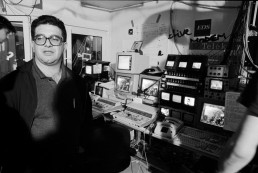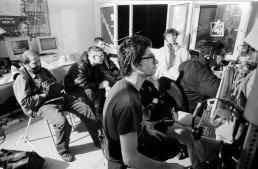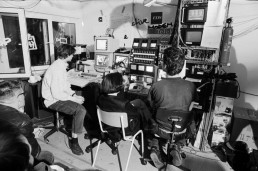Piazzettas
The production control room of Piazza virtuale in Kassel (Foto: Ali Altschaffel, altschaffel.com)
Part of the TV programme of “Piazza virtuale” was provided by the so-called “piazzettas”. These were two dozen groups and initiatives that produced broadcasts on their own in cities in Europe and Japan. The contributions of these initiatives were transmitted to Kassel via videophone, either with an analog Panasonic videophone in slow-scan mode or by ISDN videophone. However, some Piazzettas also transmitted at least temporarily by satellite.
The first Piazzetta broadcasts were aired on 27.06.1992. The groups had to register by fax the day before and were then given an airtime, which was entered on daily broadcast schedules. As more and more piazzettas participated in the last weeks of “Piazza virtuale”, there were sometimes conflicts towards the end of the project about the length and frequency with which one could go on the air. Salvatore Vanasco was responsible for the coordination of the German piazzettas. Some piazzettas were announced in press releases, for example the one from Ljubljana, which included a live connection to Belgrade, while due to the Yugoslav wars the telephone connections between the two cities had been cut, although they had belonged to the same state for decades.
The organizers of the international piazzettas were sought and prepared by Mike Hentz during months of exhaustive travel. The contacts came partly from the network he had built up through his artistic work with various groups, such as the Piazzetta Lyon – organized by the artists’ group Frigo, of which Hentz was also a member – or in Paris, run by Hentz’s artistic collaborator Christian Vanderborght. In other cities, he searched for collaborators for months, sometimes with success – as in Moscow – but sometimes without results – as in Poland. Hentz was particularly active in looking for partners in Eastern Europe, which was just beginning to open up after the fall of the Berlin Wall and the collapse of the Warsaw Pact. Some of the Eastern European piazzettas designed their programs completely independently, such as the one in Prague. At other piazzettas – such as those in Riga and Vilnius – Hentz also took part in the production. His frequent absence caused disgruntlement among the group in Kassel.
Some of the piazzettas – such as in Hamburg or Cologne – made regular programs during the entire broadcasting period, others – such as Bremen, Geneva or Zurich – were limited to a few shows during a shorter production period. Broadcasts from Freiburg and Stuttgart appeared only once in the schedule with their own programs. Beyond the official broadcasting times, the Piazzetta Bremen or Göttingen, for example, occasionally joined the program of the talk show Coffeehouse.
Some of the piazzettas cooperated with each other during their shows. Graz and Vienna broadcasted together for the most part, but there were also spontaneous, one-off collaborations, for example between the piazzettas in Cologne and Bremen or Hamburg and Paris. Some organizers also moved their activities to other locations: the makers of Piazzetta Riga broadcast several times from music festivals in Jurmala and Liepāja. Piazzetta Milan shifted its broadcasting activity for a weekend to the theater festival in Santarcangelo di Romagna.
The contributions of the Piazzettas were of great diversity. While some of them – e.g. the Piazzetta in Zurich – presented a program with detailed broadcasting concepts in advance, a more improvised, playful approach prevailed in others. Special features include Piazzetta Earth, which showed images from an onboard camera of the Space Shuttle Atlantis, Piazzetta MacWorld, which broadcast from a computer trade fair in Berlin, and Piazzetta Göttingen, which emerged from a student shared apartment. In cooperation with the Japanese television station NHK, a program was broadcasted from Nagoya. In addition to its contributions to the program on 3Sat, the Berlin Piazzetta also broadcasted regularly on the Berlin private station FAB.


